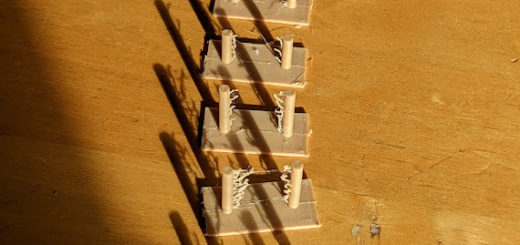Is quantum physics real?
A few weeks ago Sonya and I were talking on the subject of quantum physics, something which has been very much talked about in a book we recently finished reading, American Prometheus: The Triumph and Tragedy of J. Robert Oppenheimer by Kai Bird and Martin J. Sherwin. (It’s a a great, well-written book, and the film “Oppenheimer” is based on it but we haven’t seen the latter yet. )
Sonya asked me, “Is quantum physics real?”. It wasn’t a facetious question and if you have ever read any popular account of quantum science you probably have wondered the same thing. Certainly just about every physics student has the same nagging feeling when first presented with the subject.
Quantum physics seems unreal because more than 124 years after its revolutionary foundational ideas were introduced, they still tend to defy most peoples’ common sense notion of how the world works. The countless experimental aspects which verify the theories remain a source of wonder.
Part of the reason people may pose this question is because the truly weird and spooky aspects of quantum physics don’t often make their appearance in the every day world around us. Sure, the Sun shines because of quantum physical processes, namely fusion, which has kept the stellar generator humming along for some 4.6 billion years now. The universe, itself, began as a quantum explosion 13.9 billion years ago when everything we see and taste and touch today was concentrated into a single infinitesimally small speck of pent up energy.
In modern times, just about every electronic gadget you posses is making use of quantum physics without you ever thinking about it, but the actual quantum processes at play in these devices isn’t really viewable in the typical understanding of that word.
I spent several minutes explaining that quantum physics is real, in that we have a mathematical framework and metaphorical models that explain observations and which make verifiable predictions. At its best that is all physics can do. Physics doesn’t tell us what the world is, it only provides us with correlations between events (observations) which take place in it. I also named two of the revolutionary theories and confirming experiments that prop it up. Notably the quantization of energy idea that Plank used to explain thermal radiation spectra emitted from heated objects, and Einstein’s explanation of how photons of light (light behaving like a quantized particle) eject electrons from metals – the very process governing modern solar panels.
I’ve been pondering the discussion ever since because I felt I didn’t give a good enough answer to initial question. Thus I was tickled when I came across this recent article in Nature Communications about the use of cosmic-ray muons to find and measure heretofore unknown chambers in Egyptian pyramids. It is a larger-than-life use of quantum physics (and relativity, the other revolutionary development of early 20th century physics). It is just the sort of example that should be used to show people just how crazy physics lends itself to other branches of science. That is what I will write about in what follows.
Muon Tomography
First, a brief overview. Starting in 2016 and into 2017 a team of researchers placed sensitive muon detectors in and around King Khufu’s Great Pyramid on the Giza plateau in Egypt. Muons are highly energetic subatomic particles that are formed about 15,000 meters up, along the outer edges of our atmosphere. These particles stream down from the point of creation at a speed of 0.994 times the speed of light. Practically light speed. They have a mass that is 206 times that of an electron and so, with such a great velocity and heavy mass, they are able to penetrate solid matter far more deeply than, say, X-rays before they naturally decay, and their decay products can be sensed by the detectors previously mentioned. All this is to say that muons provide a way to obtain 3-dimensional data about large, thick objects in much the same way that X-rays are able to provide 3D data in medical CT-scanning machines. Because they are formed everywhere in the upper atmosphere, and stream in all directions, the muon detectors can be moved around to obtain the 3D data necessary to complete a scan. For reference, the muon flux (the number of muons per unit time per unit area) reaching the Earth is such that a single muon passes through an area the size of your hand (or your hand itself) about once per second. All day long, every single day.
The idea is not a new one, of course. Muons were discovered during the early days of the development of quantum mechanics, the mathematical structure underlying quantum physics, back in 1936, by physicists Carl Anderson and Seth Neddermeyer. The first use of muon tomography (what this technique is called) for exploring non-destructively the structure of pyramids was in the 1960s. What has changed recently, however, is the rapid calculating ability of modern supercomputers to process larger amounts of scanning data to produce higher resolution image results. This is described in the Nature Communications paper, with images and all. The conclusion is that a previously unknown corridor has been discovered in the Great Pyramid and its structure is known to better-than-before resolution. You should read the paper because apart from the discussion of the details of data gathering and processing, it is easy enough for non-scientists to understand. There are also some incredible images and diagrams that do a nice job of making the point.
Aside from the archaeological discovery, what excites me about all of this is the physics underlying the whole of muon tomography, and that is what I want to take you through in the rest of this already long piece.
Muon Production From Cosmic Radiation
You have probably heard of cosmic rays before. Discovered in the early part of the twentieth century they are a continuous, mostly uniform source of subatomic particles that bombard the Earth from various sources spread out in the universe. They are particles ejected from stars, including our own sun, supernova events, black holes, and other high energy events. 90% of cosmic ray particles are proton or proton-neutron pairs, the nucleus of hydrogen atoms stripped of their single electron. When these charged particles reach the outer edges of the Earth’s atmosphere they collide with other charged particles there and produce muons. These muons then rain down on the planet at a speed of ![]() , where
, where ![]() is the speed of light, 300,000,000 meters per second.
is the speed of light, 300,000,000 meters per second.
Modern physicists can also create muons as the byproduct of particle collisions in various accelerators that have been developed over the last three quarters of a century, allowing for laboratory scaled studies of these particles. One of the most interesting things physicists know about the muon is that it lives for roughly 2.2 microseconds (22 ![]() s) before it decays into an electron, an anti-electron neutrino, and a muon neutrino. The muons created 15,000 meters above our planet and which travel down at close to the speed of light would take 50.3
s) before it decays into an electron, an anti-electron neutrino, and a muon neutrino. The muons created 15,000 meters above our planet and which travel down at close to the speed of light would take 50.3 ![]() s to reach the surface. That is far longer than their lifespan. They should decay long before they reach the planet. Either cosmic muons are different than the ones created in the laboratory or something else is amiss.
s to reach the surface. That is far longer than their lifespan. They should decay long before they reach the planet. Either cosmic muons are different than the ones created in the laboratory or something else is amiss.
Before describing what that something is, we should examine what it means for a radioactive particle to have an average lifetime or for a collection of such particles to have a half-life. The decay of a radioactive particle is a probabilistic event. The moment that a particle will decay can never be predicted. The average lifetime of a radioactive particle is measured by observing thousands of such particles and measuring the time from the point of creation until they decay, and then computing an average. Some individual particles will live shorter than this lifetime and some will live longer, and some much, much longer before decaying. So when it was stated above that a muon with an average lifetime of 2.2 ![]() s would not be able to travel the 15,000 meters necessary to reach the Earth’s surface, it was not a completely true statement. It was merely expressing an improbable outcome. It would be like flipping a fair coin 100 times and having it come up heads each time. It is a possibility but an improbable one.
s would not be able to travel the 15,000 meters necessary to reach the Earth’s surface, it was not a completely true statement. It was merely expressing an improbable outcome. It would be like flipping a fair coin 100 times and having it come up heads each time. It is a possibility but an improbable one.
The half-life of a radioactive particle is the amount of time it takes for half the amount of any given collection of such particles to decay. If we produced 1,000 muons in a collider, the half-life would be how long it would take for 500 of them to decay. For muons, the half-life is 1.52 ![]() s. It is less than the average lifetime from the following reasoning. Imagine again we produce 1,000 muons in a collider and we measure the lifetime of every single one. We plot these lifetimes on a bar chart, one bar for each muon, with a height indicating the lifetime. The average is calculated as before: simply add up all the lifetimes and divide by the total number of muons. The median lifetime, what we call the half-life, is determined by drawing a horizontal line across the bar chart such that exactly half of the muons are above the line and half are below. Recall that the probabilistic nature of decay means that some of the muons will have a much great lifetime, pushing their bar heights far above the median line, thus raising the overall average. Lifetimes cannot go below zero, however, so the number of muons below the median line will never be very far below. For this reason, the average lifetime will always be greater than the half-life value.
s. It is less than the average lifetime from the following reasoning. Imagine again we produce 1,000 muons in a collider and we measure the lifetime of every single one. We plot these lifetimes on a bar chart, one bar for each muon, with a height indicating the lifetime. The average is calculated as before: simply add up all the lifetimes and divide by the total number of muons. The median lifetime, what we call the half-life, is determined by drawing a horizontal line across the bar chart such that exactly half of the muons are above the line and half are below. Recall that the probabilistic nature of decay means that some of the muons will have a much great lifetime, pushing their bar heights far above the median line, thus raising the overall average. Lifetimes cannot go below zero, however, so the number of muons below the median line will never be very far below. For this reason, the average lifetime will always be greater than the half-life value.
With that out of the way, we can use the exponential formula for radioactive decay of a collection of particles to say what fraction of muons created at 15,000 meters should make it to the Earth’s surface, at sea level. This is give by the ratio of muons at altitude, divided by the muons at sea-level,
![]()
where ![]() is the flux of muons after a time
is the flux of muons after a time ![]() starting from the flux at altitude,
starting from the flux at altitude, ![]() .
. ![]() is the muon half-life, 1.52
is the muon half-life, 1.52 ![]() s.
s.
If we use the trip time calculated before, 50.3 ![]() s, we see that
s, we see that
![]()
meaning that there is virtually no chance that we would ever measure a muon at sea level because they would have all decayed long before, roughly a thousand meters into the trip.
Not even the strangeness of quantum mechanics could explain why it is, then, that we do find muons striking the planet. Fortunately, the answer for this came from another radical theory that was introduced around the same time that quantum physics was being developed. This was the theory of special relativity, the adjustments to Newton’s laws of motion that was developed by Einstein in 1905. (In that year Einstein not only produced the ground breaking research that put quantum theory on a firm foundation, the photo-electric effect, but he also managed to produce the first of his two papers on relativity theory, as well as two other notable papers. He would win the Nobel Prize for his photo-electric effect paper.)
According to the special theory of relativity, an observer (us, on the planet Earth, for example) would notice that time seems to move slower for a moving object (a muon) that is coming towards or away from the observer. The theory predicts that the amount time slows down, versus time measured by the observer, is precisely
![]()
where ![]() is the speed of the object and
is the speed of the object and ![]() again is the speed of light. You can see why we normally don’t notice this time shift. Most objects we see don’t move nearly close to the speed of light, so
again is the speed of light. You can see why we normally don’t notice this time shift. Most objects we see don’t move nearly close to the speed of light, so ![]() is practically zero, and the time shift is immeasurable. For the muon, however, this isn’t the case. The term in the square root is
is practically zero, and the time shift is immeasurable. For the muon, however, this isn’t the case. The term in the square root is ![]() , and
, and ![]() . While we might measure a non-moving, local muon to live for 2.2
. While we might measure a non-moving, local muon to live for 2.2 ![]() s, one that is moving towards us at close the speed of light would experience a longer life,
s, one that is moving towards us at close the speed of light would experience a longer life, ![]()
![]() s thanks to relativity! From a probability perspective, then, we would expect some of those muons to exceed the average lifetime and reach the planet. In fact, the half-life we would observe for fast moving muons would be
s thanks to relativity! From a probability perspective, then, we would expect some of those muons to exceed the average lifetime and reach the planet. In fact, the half-life we would observe for fast moving muons would be ![]()
![]() s, or 13.9
s, or 13.9 ![]() s. If this is the case, the fraction of muons reaching the planet then becomes
s. If this is the case, the fraction of muons reaching the planet then becomes
![]()
Muon flux at altitude, about 1,000 per square meter per second, would then be around 27 per square meter per second, or roughly 1 per square centimeter per minute, the number that has been measured numerous times since the muon was discovered. The measurement of this flux rate is yet another confirmation of the special theory of relativity.
Of course relativity works both ways. From the point of view of the muon, it doesn’t sense that time has slowed down. However, the other aspect of special relativity is that for a stationary observer (the muon now), lengths in motion towards or away are contracted, and by an amount that is given by a similar transformation as for time. In this case, the distance that the muon sees itself traveling through is shortened by ![]() , or
, or ![]() meters. With such a short distance, a collection of muons has sufficient time to make the journey before decaying.
meters. With such a short distance, a collection of muons has sufficient time to make the journey before decaying.
There you have it. This is why this Nature article is so appealing to me. It makes use of quantum physics as well as Einstein’s special theory of relativity in a real-world, practical application. Furthermore, researchers from MIT have developed a $100 pocket-sized muon detectorthat brings this technology into the hands of even high school students. It is a fantastic instructional aid.



Recent Comments